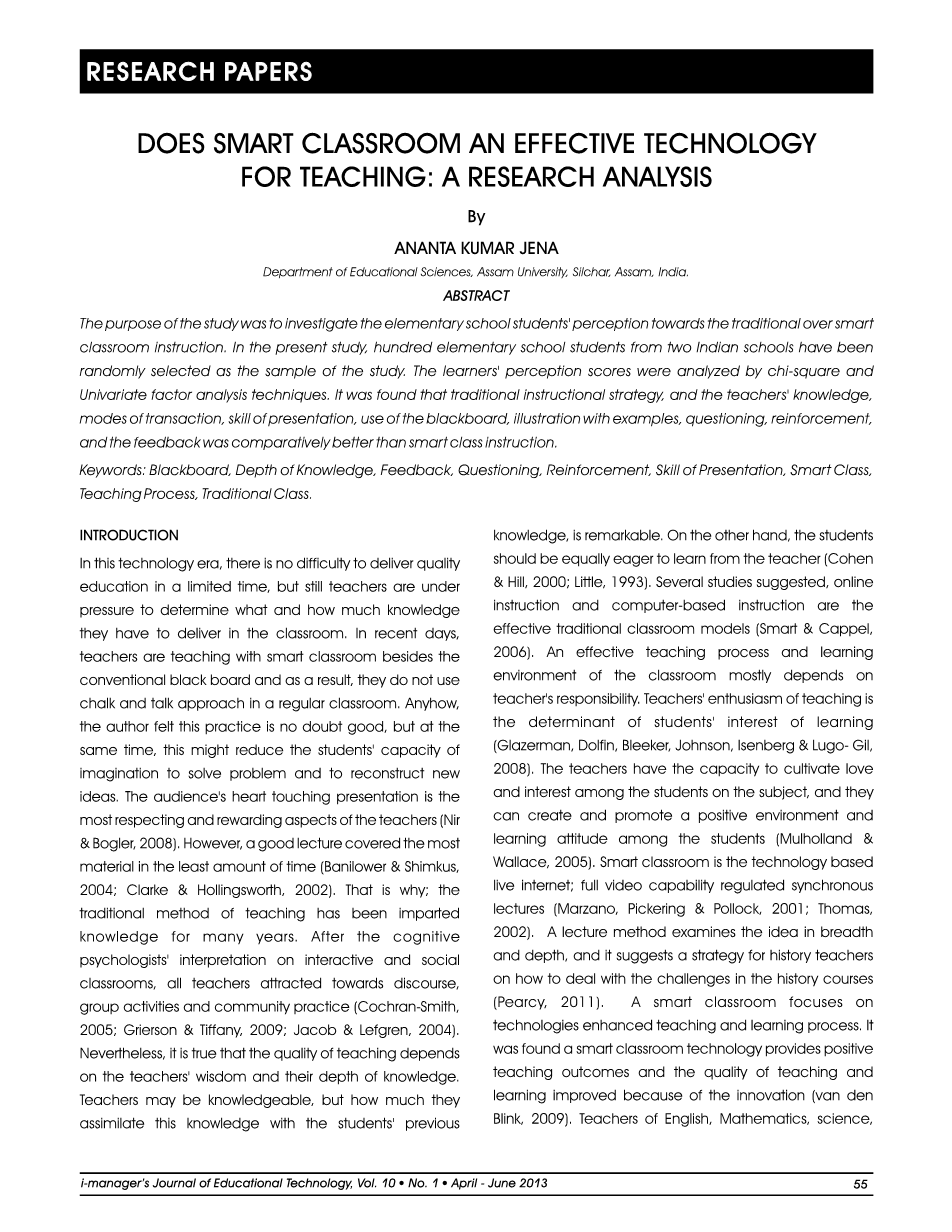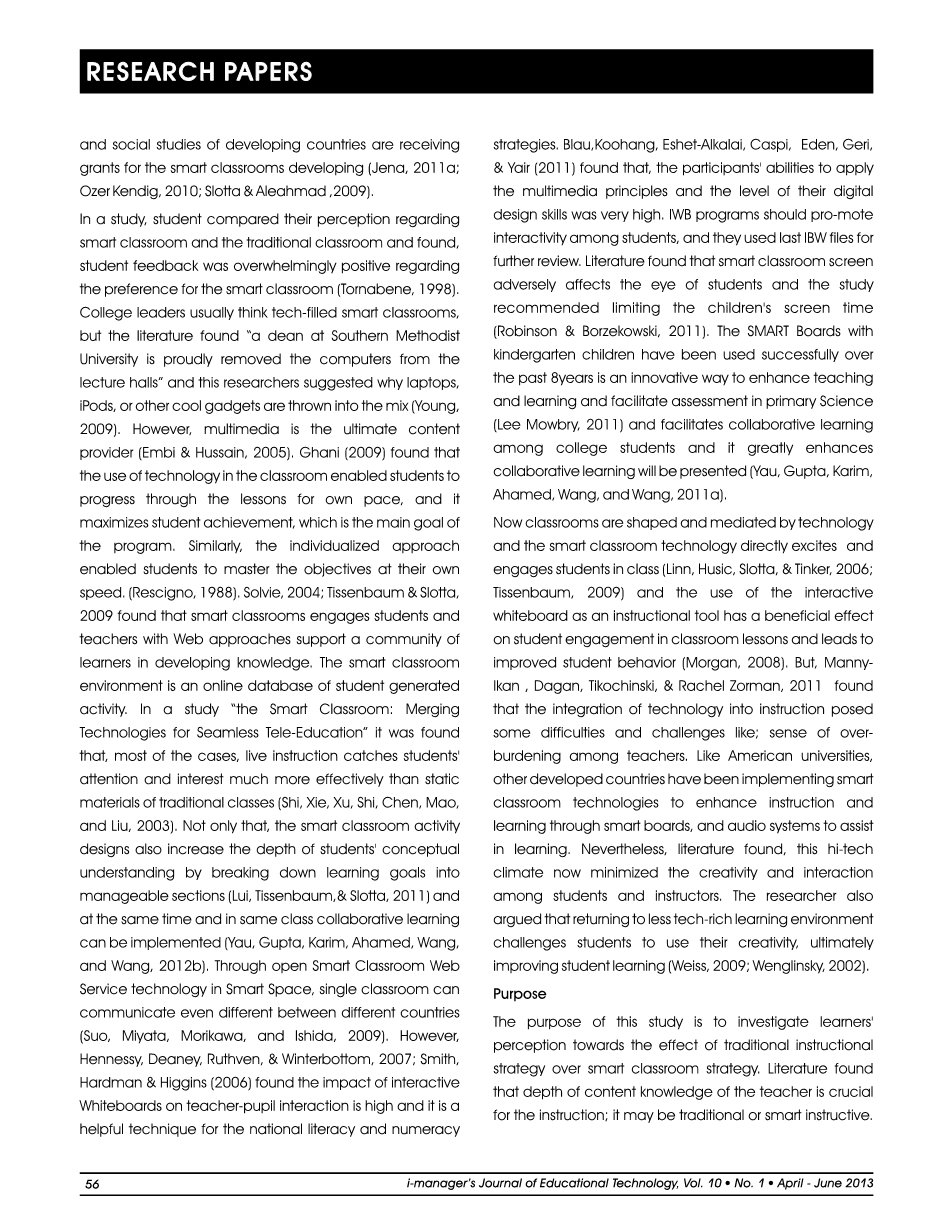本科毕业设计(论文)
外文翻译
DOES SMART CLASSROOM AN EFFECTIVE TECHNOLOGY FOR TEACHING: A RESEARCH ANALYSIS
作者:Ananta Kumar Jena
国籍:India
出处:Department of Educational Sciences, Assam University, Silchar, Assam, India.
原文正文:
ABSTRACT
The purpose of the study was to investigate the elementary school students perception towards the traditional over smart classroom instruction. In the present study, hundred elementary school students from two Indian schools have been randomly selected as the sample of the study. The learners perception scores were analyzed by chi-square and Univariate factor analysis techniques. It was found that traditional instructional strategy, and the teachers knowledge, modes of transaction, skill of presentation, use of the blackboard, illustration with examples, questioning, reinforcement, and the feedback was comparatively better than smart class instruction.
Keywords: Blackboard, Depth of Knowledge, Feedback, Questioning, Reinforcement, Skill of Presentation, Smart Class, Teaching Process, Traditional Class
INTRODUCTION
In this technology era, there is no difficulty to deliver quality education in a limited time, but still teachers are under pressure to determine what and how much knowledge they have to deliver in the classroom. In recent days, teachers are teaching with smart classroom besides the conventional black board and as a result, they do not use chalk and talk approach in a regular classroom. Anyhow, the author felt this practice is no doubt good, but at the same time, this might reduce the students capacity of imagination to solve problem and to reconstruct new ideas. The audiences heart touching presentation is the most respecting and rewarding aspects of the teachers (Nir amp; Bogler, 2008). However, a good lecture covered the most material in the least amount of time (Banilower amp; Shimkus, 2004; Clarke amp; Hollingsworth, 2002). That is why; the traditional method of teaching has been imparted knowledge for many years. After the cognitive psychologists interpretation on interactive and social classrooms, all teachers attracted towards discourse, group activities and community practice (Cochran-Smith, 2005; Grierson amp; Tiffany, 2009; Jacob amp; Lefgren, 2004). Nevertheless, it is true that the quality of teaching depends on the teachers wisdom and their depth of knowledge. Teachers may be knowledgeable, but how much they assimilate this knowledge with the students previousknowledge, is remarkable. On the other hand, the students should be equally eager to learn from the teacher (Cohen amp; Hill, 2000; Little, 1993). Several studies suggested, online instruction and computer-based instruction are the effective traditional classroom models (Smart amp; Cappel, 2006). An effective teaching process and learning environment of the classroom mostly depends on teachers responsibility. Teachers enthusiasm of teaching is the determinant of students interest of learning (Glazerman, Dolfin, Bleeker, Johnson, Isenberg amp; Lugo- Gil, 2008). The teachers have the capacity to cultivate love and interest among the students on the subject, and they can create and promote a positive environment and learning attitude among the students (Mulholland amp; Wallace, 2005). Smart classroom is the technology based live internet; full video capability regulated synchronous lectures (Marzano, Pickering amp; Pollock, 2001; Thomas, 2002). A lecture method examines the idea in breadth and depth, and it suggests a strategy for history teachers on how to deal with the challenges in the history courses (Pearcy, 2011). A smart classroom focuses on technologies enhanced teaching and learning process. It was found a smart classroom technology provides positive teaching outcomes and the quality of teaching and learning improved because of the innovation (van den Blink, 2009). Teachers of English, Mathematics, science, and social studies of developing countries are receiving grants for the smart classrooms developing (Jena, 2011a; Ozer Kendig, 2010; Slotta amp; Aleahmad ,2009).
In a study, student compared their perception regarding smart classroom and the traditional classroom and found, student feedback was overwhelmingly positive regarding the preference for the smart classroom (Tornabene, 1998). College leaders usually think tech-filled smart classrooms, but the literature found “a dean at Southern Methodist University is proudly removed the computers from the lecture halls” and this researchers suggested why laptops, iPods, or other cool gadgets are thrown into the mix (Young, 2009). However, multimedia is the ultimate content provider (Embi amp; Hussain, 2005). Ghani (2009) found that the use of technology in the classroom enabled students to progress through the lessons for own pace, and it maximizes student achievement, which is the main goal of the program. Similarly, the individualized approach enabled students to master the objectives at their own speed. (Rescigno, 1988). Solvie, 2004; Tissenbaum amp; Slotta, 2009 found that smart classrooms engages students and teachers with Web approaches support a community of learners in developing knowledge. The smart classroom environment is an online database of student generated activity. In a study “the Smart Classroom: Merging Technologies for Seamless Tele-Education” it was found that, most of the cases, live instruction catches students attention and interest much more effectively than static materials of traditional classes (Shi, Xie, Xu, Shi, Chen, Mao, and Liu, 2003). Not
剩余内容已隐藏,支付完成后下载完整资料


英语原文共 10 页,剩余内容已隐藏,支付完成后下载完整资料
资料编号:[273109],资料为PDF文档或Word文档,PDF文档可免费转换为Word
您可能感兴趣的文章
- 酞菁钴诱导的二维黑色鳞光体铁磁性外文翻译资料
- 用于光学非线性测量的带相位物体的时间分辨泵浦探测技术外文翻译资料
- 专业知识和任务指导专一性是准教师专业视野的影响因素外文翻译资料
- 物理学中的探索太阳能热水器物理概念教学的建议外文翻译资料
- 与传统教学相比,翻转教学对工科学生在物理实验室表现的有效性的数据集外文翻译资料
- 什么是伟大的教学?(P8-P17)外文翻译资料
- 早期外语学习对初中至高中语言能力发展的影响外文翻译资料
- 单负和双正材料组合结构中电磁波隧穿现象的研究外文翻译资料
- 对美国宾夕法尼亚Marcellus气井回流盐水的地球化学评价外文翻译资料
- 中国的探究式学习:教师们是否真的实践了他们所宣扬的,为什么?外文翻译资料


